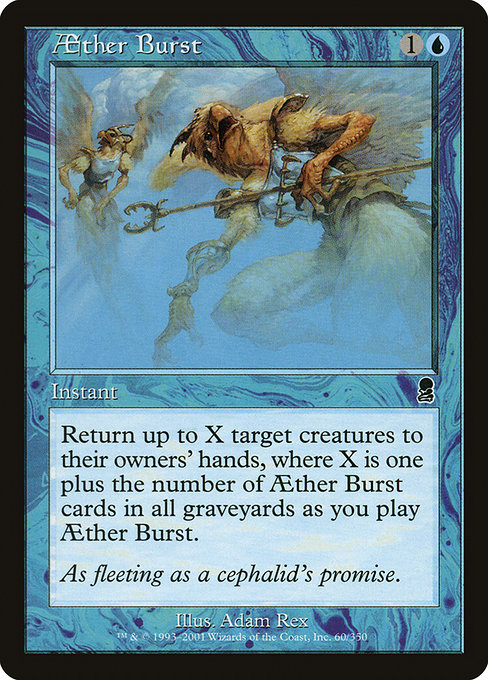
Image courtesy of Scryfall.com
Where the art and the spellwork collide: reading flavor in blue’s tempo play
Blue magic in MTG is the mind’s playground—tempo, information, and timing all wrapped in a veil of shimmering aether. Aether Burst, an Odyssey-era instant costing {1}{U}, is a perfect ambassador for that vibe. Its aim isn’t to crush foes with brute force but to pivot the battlefield in an instant, sending creatures back to their owners’ hands while inching the game toward a center stage where plan after plan can collide with counterplay. The card’s rules text—Return up to X target creatures to their owners' hands, where X is one plus the number of cards named Aether Burst in all graveyards as you cast this spell—reads like a tiny puzzle box. The art that accompanies it reinforces that puzzle box in a single, elegant moment. 🧙♂️🔥💎
Art as a parable for manipulation and momentum
Adam Rex’s illustration for Aether Burst conjures a swift, almost breath-like displacement of creatures through the ether. You can sense motion—twists of blue energy curling around the edges of a binding instant that can arc across a battlefield in a heartbeat. This isn’t a booming dragon or a towering golem; it’s a deft correction of the tempo, a blue spell quietly asserting that speed, not raw power, wins the day. The artwork invites you to feel the moment the battlefield shifts: a timely bounce that resets the board, buys time, and reshapes threats with surgical precision. It’s the kind of flavor that makes you want to pause and read the card twice, savoring the idea that in a game of perfect information and chance, a single burst of Aether might tilt the whole exchange. 🎨⚔️
As fleeting as a cephalid's promise.
This flavor text, simple and evocative, anchors the spell in the Odyssey period where storytelling leaned into mythic sea-craft and the slippery mysteries of blue magic. The cephalid reference isn’t just window dressing; it’s a wink to the era’s lore where underwater schemers and schemata swirled through the hidden corners of Dominaria’s post-Tempest world. For players, that line nudges you to consider how a single, well-timed bounce can be as dramatic as any single combat win—blue’s magic is often about what you prevent from happening as much as what you pull off. 🧙♂️🎲
How the card’s mechanics ride flavor to the top of the deck
The spell’s X is determined by the number of copies named Aether Burst already in all graveyards as you cast it. In practice, that means you’re not just counting your own graveyard; you’re reading the broader memory of the game—what’s been discarded, what’s slipped into the ether, what your opponent might reanimate later. It’s a mechanic that leans into the blue playbook: tracking information, leveraging memory, and exploiting timing windows. Returning creatures to their owners’ hands can slow an aggressive start, reset a troublesome ETB trigger, or simply force the opponent to reload threats you’ve already answered. And because the card is common in Odyssey, players at kitchen-table tables and at paper FNM nights alike could experiment with it, trading the gamble of a large X for the safety of a flexible bolt-action answer. The concept remains timeless: blue loves options, and Aether Burst hands you a handful of options by paying with a little blue mana and a lot of forethought. 🧙♂️💎
From the table to a collector’s shelf: the art’s enduring appeal
Beyond the battlefield, Aether Burst offers a window into the era’s aesthetic—an era where the art team explored more painterly, narrative-driven scenes that still felt perfectly game-ready. The Odyssey set—blue’s home in this vignette—was all about exploring the margins of control: cards that keep options open, that pivot the board with a flick of the wrist rather than a hammer blow. Rex’s piece captures that essence with just the right balance of motion and restraint, inviting players to imagine the unseen moments when the ether shimmers and a creature hops back to its owner’s hand. It’s the kind of piece that can spark conversations about card design, illustration, and the way a single image can deepen strategic intent. And for collectors, the card’s common status means plenty of players owned a copy, which can influence trading narratives and price memory—nostalgia you don’t have to pay through the nose for, yet still worth cherishing. 🧙♂️🔥🎨
For modern players, Aether Burst remains a thoughtful reminder of how art shapes perception. The visual language—swirling blues, arcs of light, and the suggestion of movement—prepares your brain to see opportunities where others might see only a tempo swing. It’s not just “cast this, bounce that”; it’s an invitation to choreograph a few steps across the board, to set up future turns with careful reading of the graveyard’s composition, and to enjoy a moment of elegance when the last creature vanishes from the battlefield, only to reappear in someone else’s hand. The synergy between art and mechanic is what keeps MTG’s flavor loop so enduringly satisfying. 🧙♂️🎲
Where to find this vibe in current play and how to pair it with your setup
If you’re chasing the Odyssey vibe in your current cube, PoG, or commander chaos, Aether Burst is a solid historical compass: a blue common that translates well across formats that still honor legacy and casual legacy-like windows. It’s a reminder that a spell’s true power often lives in what it makes you do next—read the board, anticipate your opponent’s graveyard state, and decide whether to save a threat or reset a big board impact. And while you plan your next moves, you can keep a tidy, distraction-free desk space with a trustworthy mouse pad. The product below offers a clean canvas for long sessions, helping you keep your focus where it belongs—on the art, the math, and the mirror of the stack. 🧙♂️💎⚔️